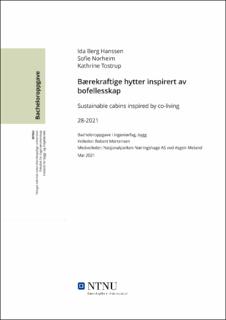| dc.contributor.advisor | Mortensen, Robert | |
| dc.contributor.advisor | Nasjonalparken Næringshage AS ved Asgeir Meland | |
| dc.contributor.author | Hanssen, Ida Berg | |
| dc.contributor.author | Norheim, Sofie | |
| dc.contributor.author | Tostrup, Kathrine | |
| dc.date.accessioned | 2021-09-20T16:30:32Z | |
| dc.date.available | 2021-09-20T16:30:32Z | |
| dc.date.issued | 2021 | |
| dc.identifier | no.ntnu:inspera:81154281:81155209 | |
| dc.identifier.uri | https://hdl.handle.net/11250/2779540 | |
| dc.description.abstract | Denne bacheloroppgaven skrives på oppdrag av Nasjonalparken Næringshage fra Oppdal, og tar for seg ideen om Urbanhytta, som har blitt utviklet gjennom forprosjektet Grønn Fjellhageby. Urbanhytta beskrives som sentrumsnære hytter med middels til høy standard, og målet er at de skal være 365-dagers hytter. Det er allerede utpekt et aktuelt område nær Oppdal sentrum hvor disse hyttene kan plasseres.
Oppgaven har som mål å presentere et helhetlig konsept for hva Urbanhytta kan være. Dette gjøres ved å definere en målgruppe og kartlegge deres behov, utforme en forretningsmodell for hyttene og en reguleringsplan for området. Samlet skal dette gi innspill til videre utvikling av Urbanhytta.
Gjennom å innhente relevant litteratur, gjennomføre samtaler med eksterne aktører og ved å utføre en spørreundersøkelse, har man forsøkt å danne et bredt grunnlag for å kunne utvikle et konsept. Resultatet har blitt Urbanhytta Hyttefellesskap: 17 hytter som er inspirert av bofellesskap. Tre forslag til planløsning er lagt fram, og innebærer en stor hytte med hems, en stor hytte uten hems, samt en liten hytte. Hyttene har alle fasiliteter, og deler på felles arealer og funksjoner. Håndboken «Gaining by Sharing – en studie av bærekraftig boform» har spilt en stor rolle i valget av retning for konseptet. Det foreslås hvordan man kan gjøre hyttebruk mer bærekraftig, inkludert utfordringer knyttet til transport. Hyttene skal bygges i tre, og bærekraft skal ligge til grunn i alle valg av materialer. I tillegg kan Urbanhytta brukes som forskningsobjekt ved at en eller flere av hyttene benyttes som en «living lab».
Det må vurderes hvorvidt det tildelte området er det beste stedet å bygge på, da grunnen i stor grad består av myr. Dersom man velger å bygge her, må det tas veloverveide valg angående fundamentering. Det vil også være interessant å se hvorvidt fordelene ved å bo i et bofellesskap er overførbart til den norske hytteheimen. | |
| dc.description.abstract | This bachelor thesis is written for Nasjonalparken Næringshage of Oppdal and addresses the idea of Urbanhytta (“the urban cabin”), developed through the preliminary project Grønn Fjellhageby. Urbanhytta is described as central cabins with medium to high standard, and the goal is for them to act as 365-day cabins. A designated spot for the cabins, close to downtown Oppdal, has already been chosen.
The goal of the thesis is to present a general concept of what Urbanhytta could be. This is done by defining a target group and mapping out their needs, as well as designing a business model for the cabins and a zoning plan for the area. Altogether, this is meant to provide input for further development of Urbanhytta.
Through gathering relevant literature, talking to external actors, and by performing a survey, one has attempted to form a wide basis to be able to develop a concept. The result is Urbanhytta community of cabins: 17 cabins inspired by co-living. Three different floor plans have been designed, and include a large cabin with loft, a large cabin without loft, and a small cabin. The cabins have all facilities and share common spaces and functions. The handbook “Gaining by Sharing – a study of sustainable co-living” has played a large part when choosing the direction of the concept. It is suggested how to make the use of cabins more sustainable, including challenges linked to transportation. The cabins will be built in wood, and sustainability should be the basis for all choice of materials. In addition, Urbanhytta is to be used as a research object by designating one or more of the cabins as a living lab.
It must be considered whether the designated area is the best place for construction, being that the ground is mainly bogland. If one chooses to build the cabins here, the choice of foundation method must be well considered. It will also be interesting to see whether the benefits of co-living is transferable to Norwegian cabin culture. | |
| dc.language | nob | |
| dc.publisher | NTNU | |
| dc.title | Bærekraftige hytter inspirert av bofellesskap | |
| dc.type | Bachelor thesis | |
